Are you tired of casting your line out only to see it get snagged up due to dirt and debris? Or maybe you notice that your casting distance has decreased due to a buildup on your fly line. Here’s how to clean fly line and keep it in top condition.
Maintaining your fly line in pristine condition is essential for any angler wishing to optimize their casting performance and extend the lifespan of their gear. Cleaning your fly line not only removes dirt and algae that can accumulate during fishing trips but also restores its smoothness and buoyancy, facilitating more effortless casting and better line floatation. This concise guide aims to introduce you to the simple yet effective process of cleaning your fly line.
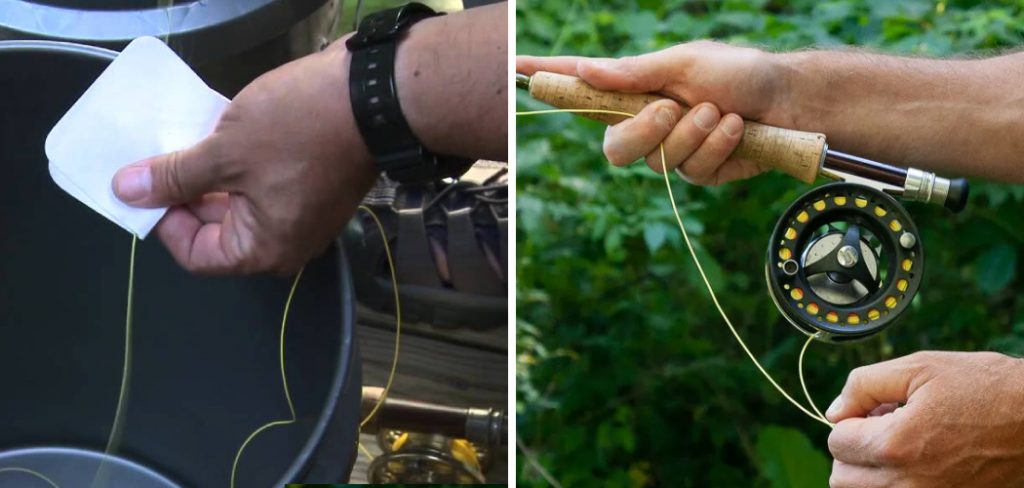
Whether you’re a seasoned pro or just starting out, these steps will ensure your line remains in top condition, enhancing your overall fishing experience.
What are the Benefits of Cleaning Fly Lines?
Before getting into the cleaning process, it’s essential to understand why it’s necessary. Here are some of the benefits of regularly cleaning your fly line:
- Improved Casting Distance and Accuracy: Dirt and debris can accumulate on your line, creating friction between the guides and reducing their ability to slide through smoothly. This buildup can decrease your casting distance or cause your line to land in a different spot than intended.
- Increased Floatation: Fly lines are designed to float on the water’s surface, allowing you to control the movement of your fly. Over time, dirt and algae can cause your line to sink or sit lower in the water, affecting its performance.
- Extended Lifespan: Regularly cleaning your fly line helps remove any corrosive substances present due to exposure to saltwater or harsh weather conditions. This prevents damage and prolongs the life of your flyline.
These are just a few benefits of keeping your fly line clean. Now, let’s explore the steps for cleaning it.
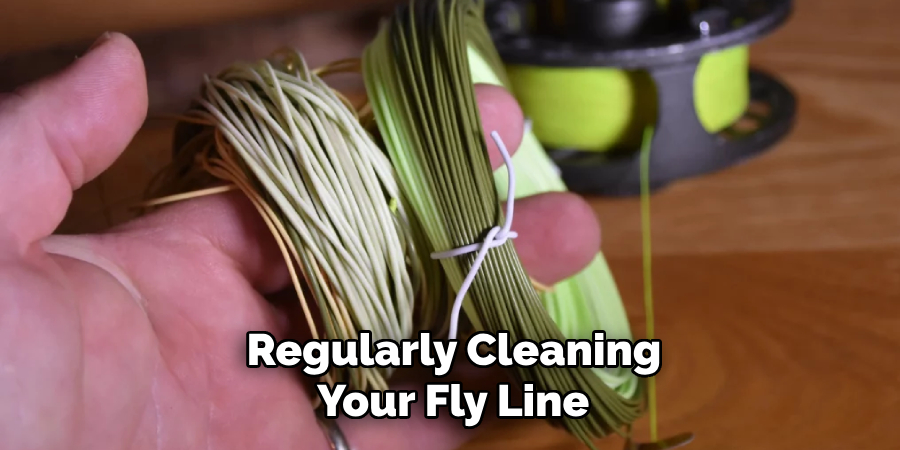
What Will You Need?
Before you begin, make sure you have all the necessary supplies. Here’s what you’ll need:
- Mild Soap or Specialized Fly Line Cleaner: Avoid using harsh chemicals or household cleaners as they can damage the coating on your fly line.
- Clean Towel: To dry your fly line after cleaning.
- Bucket/ Basin of Warm Water: To soak and rinse your flyline.
- Clean Cloth or Sponge: This cleans the line’s surface.
Once your supplies are ready, follow these simple steps to clean your fly line.
10 Easy Steps on How to Clean Fly Line:
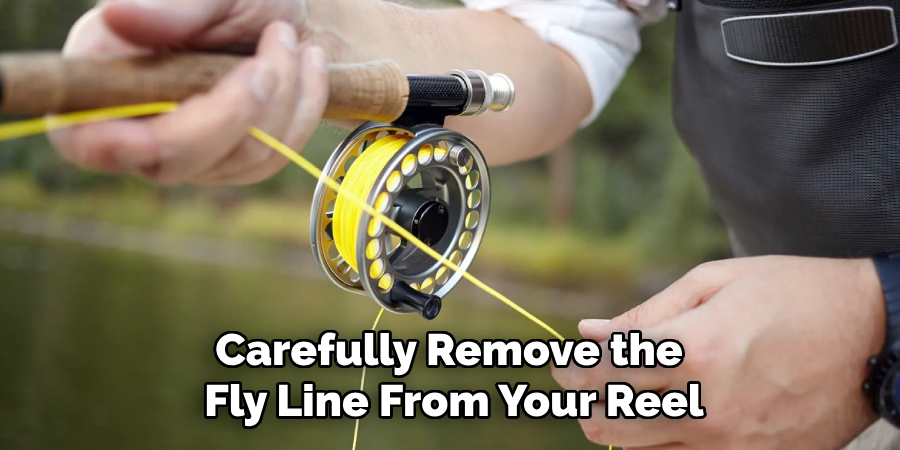
Step 1. Prepare Your Work Area:
Start by choosing a clean, flat surface near a water source. Setting up your cleaning station outdoors, such as on a patio or deck, can be ideal, but ensure it’s not a dusty or dirty environment that could further contaminate the line. Lay out all your cleaning supplies within easy reach to streamline the process. If you’re cleaning your flyline indoors, protect your surfaces with a plastic sheet or old newspapers to catch any spills or drips.
Step 2: Strip the Line From Your Reel:
Carefully remove the fly line from your reel, ensuring that you do so in a manner that prevents it from getting tangled. You can lay it out on the ground in loose coils or use a line winder if you have one available. This step is crucial as it allows you to clean the entire length of the fly line thoroughly without missing any sections that may be dirty or damaged. It’s also an excellent opportunity to inspect the line for any signs of wear or damage that might affect its performance. Once the line is fully stripped from the reel, you can proceed to the next step.
Step 3: Soak the Line in Warm, Soapy Water:
Fill your bucket or basin with lukewarm water and add mild soap or specialized fly line cleaner. Submerge the entire length of your fly line in the solution, ensuring it’s fully soaked. Allow it to sit for a few minutes to loosen any dirt, grime, or algae that have built up on the line. This soaking process helps break down contaminants, making them easier to remove during cleaning. Avoid using hot water as it can damage the line’s coating and affect performance.
Step 4: Gently Clean the Line:
Using your clean cloth or sponge, gently wipe the fly line. Start from one end and move slowly towards the other, carefully cleaning the entire length. Make sure to apply just enough pressure to remove dirt without damaging the line’s surface. If you encounter areas with more stubborn grime, you may need to soak them a bit longer or use a soft-bristled brush for a more thorough cleaning, always being careful not to apply too much force. This step is critical for ensuring that your fly line is free of any substances that can hinder its performance.
Step 5: Rinse the Line:
After thoroughly cleaning the line, the next step is to rinse it to remove any soap residue. Replace the soapy water in your bucket or basin with clean, lukewarm water. Submerge your fly line in the freshwater, gently agitating it to ensure all traces of soap are washed away. You may need to change the water and rinse multiple times to provide a thorough cleaning. No soap must remain on the line, as it could affect the line’s buoyancy and smoothness when casting.
Step 6: Dry the Line:
Once the fly line is fully rinsed, gently remove it from the water and lay it out on a clean towel. Pat the line dry with the towel to remove excess water, being careful not to stretch or distort the line. Allow the fly line to air dry completely before rewinding it onto your reel for best results. You can hang the line in a shaded area or lay it out flat on a clean surface, avoiding direct sunlight, which may damage the line’s material. Ensuring the line is dry before storage prevents mold and mildew growth, thus preserving its integrity and performance.
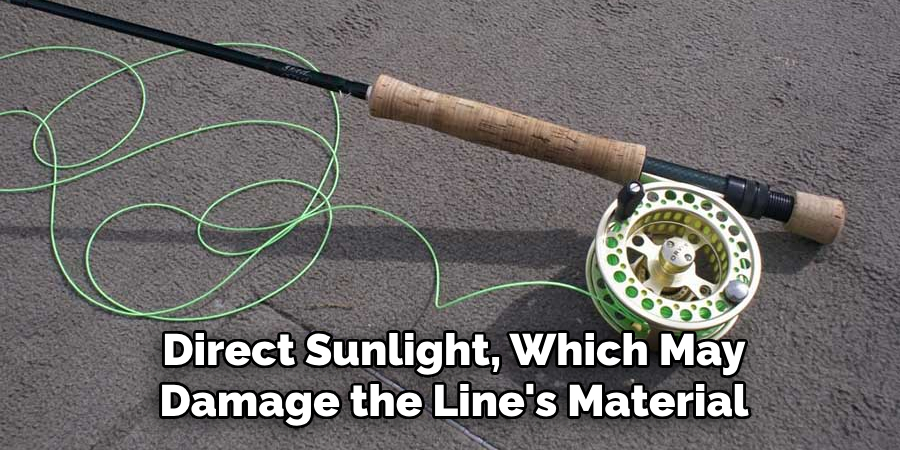
Step 7: Inspect for Damage:
With your fly line clean and dry, now is the perfect time to closely inspect the entire length for any signs of wear or damage. Look for cracks, splits, or any areas that seem unusually stiff or brittle. Also, check the line’s coating for consistency and smoothness, as irregularities could impact performance. If you find any damaged sections, it might be time to consider a repair or replacement to ensure your fly line continues to perform optimally.
Step 8: Apply Line Dressing (Optional):
After the fly line is clean, dry, and inspected for damages, you might consider applying a line dressing to enhance its performance. Line dressing is a conditioner that can be used on the fly line to help it float better and slide through the guides on your rod more smoothly.
To apply line dressing, squeeze a small amount onto a clean, dry cloth. Gently run the cloth along the length of the fly line, ensuring even coverage. It’s crucial not to overapply the dressing, as too much can attract dirt and debris, negating the benefits. After applying, allow the line to sit for a few minutes for the dressing to absorb fully.
Next, take a fresh, dry cloth and lightly buff the flyline. This helps remove any excess dressing and ensures the line is not slippery, which could make casting and handling difficult. Buffing also helps distribute the dressing evenly across the line’s surface, ensuring optimal performance.
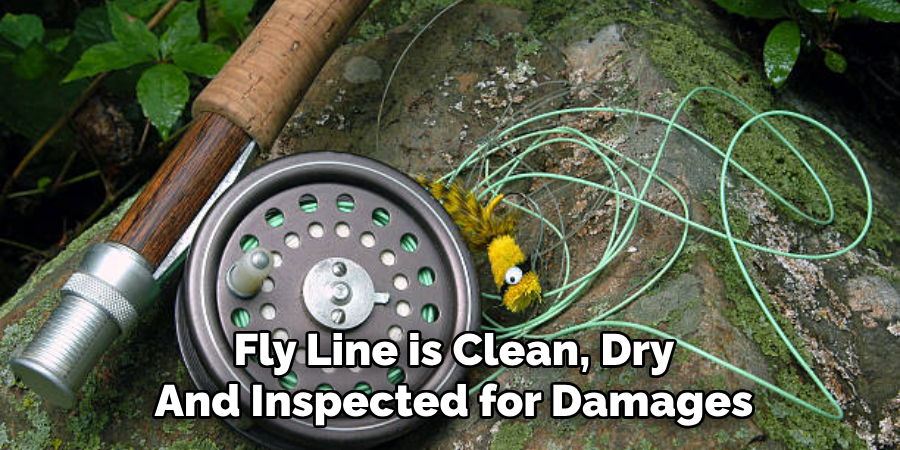
Applying line dressing is optional, but many anglers find it significantly enhances their fly line’s lifespan and functionality, especially in challenging fishing conditions. Always ensure your chosen dress is compatible with your line’s material and intended use.
Step 9: Rewind the Line onto Your Reel:
With the fly line clean, dry, optionally dressed, and inspected for any damages, the final step is carefully rewind it back onto your reel. Ensure the reel and anything it touches during the process is clean to avoid recontaminating the line. Tightly secure the end of the fly line to the reel, then slowly start winding, keeping an even tension to avoid creating loops or kinks.
It’s important to wind the line in the same direction it unwinds to preserve its natural coil and prevent tangling. This process not only prepares your gear for its subsequent use but also prolongs the life of your fly line by ensuring it’s stored in optimal conditions. Proper storage minimizes the chances of damage and keeps the line ready for your next fishing adventure.
Step 10: Store Your Fly Line Properly:
Ensuring your fly line is stored properly after cleaning and rewinding it onto your reel is crucial for maintaining its quality and performance. Store the reel and line in a cool, dry place away from direct sunlight and extreme temperatures when not in use. UV radiation and heat can degrade the materials of the flyline, leading to a loss of flexibility and strength.
If possible, hang the reel in a position that prevents the line from being tightly coiled or kinked, as this can cause permanent deformities in its shape, affecting casting accuracy. For long-term storage, consider removing the line from the reel and storing it loosely coiled in a large, breathable bag or container to keep it in its best condition. Proper storage is the key to ensuring your fly line remains supple, strong, and ready for your next fishing trip.
Following these ten steps, you can keep your fly line clean, well-maintained, and performing at its best.
5 Additional Tips and Tricks:
- Use a Mild Soap Solution: A little bit of mild, environmentally friendly soap mixed with water can work wonders in cleaning your flyline. Just make sure the soap is gentle enough not to damage the line.
- Soft Cloth Application: Instead of immersing the entire line in water, apply the soap solution with a soft cloth or sponge. This method allows for targeted cleaning of dirtier sections without soaking the whole line.
- Air Dry Completely: After cleaning, ensure that your fly line is completely dry before winding it back onto the reel. Drying helps prevent mold and mildew growth, which can degrade the quality of the line over time.
- Avoid Direct Sunlight While Drying: While it’s important to air dry the line, avoid leaving it in direct sunlight. The sun’s UV rays can weaken the plasticizers that keep the line flexible, leading to cracks and breaks.
- Regular Maintenance Checks: Regularly check your fly line for any signs of wear or damage. Look for cracks, dryness, or any abrasions. Early detection of these issues can help you maintain the line’s performance and prolong its lifespan.
With these additional tips and tricks, you can ensure your fly line remains clean and in top condition for your next fishing trip.

5 Things You Should Avoid When Cleaning Your Fly Line
- Do Not Use Harsh Chemicals: Harsh chemicals or detergents can cause significant damage to your fly line, stripping away essential oils and leading to brittleness and cracking. Stick to mild, environmentally friendly soaps.
- Avoid Submerging in Hot Water: Extreme temperatures, especially hot water, can warp your flyline or alter its properties. Always use lukewarm or room-temperature water for cleaning.
- Never Use Abrasive Scrubbers: Hard brushes or abrasive cloths can scratch and degrade the surface of your flyline. Always opt for soft cloths or sponges to gently remove dirt without causing damage.
- Do Not Store Wet: Storing your fly line while it is still wet can encourage the growth of mold and mildew, which can weaken and damage the line over time. Ensure the line is thoroughly dry before storing.
- Resist the Urge to Stretch: While it might be tempting to stretch your fly line to remove coils or twists during the cleaning process, this can weaken the line’s structural integrity. Avoid pulling or stretching the line excessively.
By steering clear of these common pitfalls, you can help preserve the longevity and performance of your fly line, ensuring that it remains a reliable tool for your angling adventures.
What are the Causes of Fly Line Damage?
Various factors can lead to fly line damage, including:
- Exposure to Sunlight: Extended exposure to direct sunlight can weaken the plasticizers in the line, causing it to become brittle and prone to cracks.
- Contact with Abrasive Surfaces: Rubbing against rocks, sand, or other abrasive surfaces can cause abrasions and cuts on the flyline.
- Improper Storage: Storing a wet or dirty fly line can lead to the growth of mold and mildew, which can weaken and damage the line over time.
- Lack of Maintenance: Neglecting to clean and maintain your fly line regularly can build up dirt, debris, and other contaminants, affecting its performance and lifespan.
- Improper Use: Using the wrong weight or type of fly line for a particular fishing situation can cause damage and decrease its effectiveness.
By being aware of these potential causes, you can take steps to prevent damage and prolong the life of your fly line.
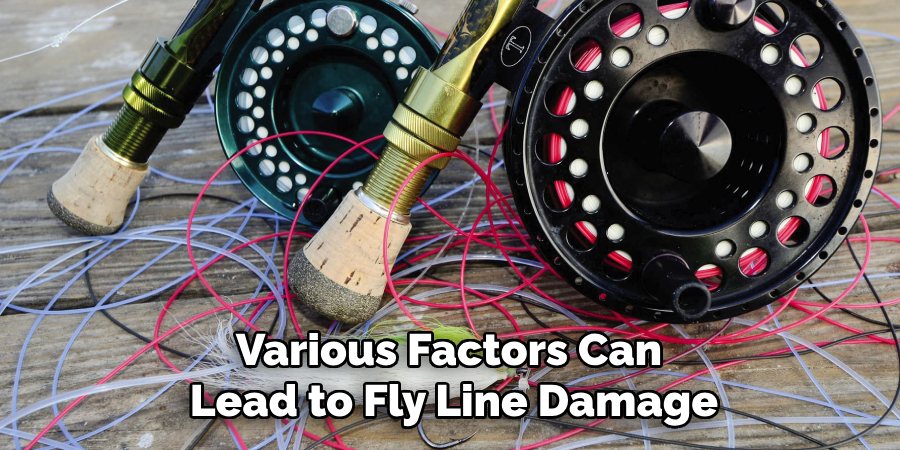
How Can You Maintain the Shine and Smoothness of Your Fly Line?
To maintain the shine and smoothness of your fly line, here are a few tips:
- Wash After Every Use: Clean your fly line after every fishing trip to remove any dirt or debris that may have accumulated.
- Use a Fly Line Dressing: After cleaning, apply a small amount of specialized fly line dressing product to your line to help maintain its slickness and smooth casting.
- Properly Store Your Line: After drying, store your fly line in a cool, dry place away from direct sunlight and extreme temperatures.
- Inspect Regularly: Inspect your fly line regularly for signs of wear or damage and address any problems promptly.
Following these maintenance practices lets you keep your fly line looking and performing like new for many fishing trips.

How to Make Fly Line Shoot Better?
To make your fly line shoot better, here are a few tips:
- Clean and Dress Regularly: As mentioned previously, cleaning and applying a fly line dressing can help maintain the slickness and smoothness of the line, allowing it to shoot through the guides more efficiently.
- Use Proper Casting Techniques: Practice correct casting techniques to reduce friction and resistance, allowing the line to shoot through the guides more easily.
- Choose the Right Fly Line: Different types and weights of fly lines are designed for specific fishing scenarios. Choosing the right one for your preferred fishing style can significantly affect its shooting ability.
- Avoid Overloading: Do not overload your fly line with heavy flies or excessive weight, as this can cause it to tangle and hinder its shooting performance.
- Replace Worn Out Line: When your fly line shows signs of wear or age, it’s time to replace it with a new one. This will ensure optimal shooting performance and casting distance.
Taking care of your fly line and using proper techniques can improve your shooting ability and have a more enjoyable and successful fishing experience.
Conclusion
In conclusion, proper care and maintenance of your fly line are critical for preserving its performance and extending its life. Anglers can protect their investment by incorporating gentle cleaning methods, avoiding harsh chemicals and extreme conditions, and adhering to regular maintenance routines.
Remembering the tips and precautions shared in this guide will ensure your fly line remains pristine and enhance your overall fishing experience. With these practices in place, your fly line will continue to provide smooth, efficient casts and reliable service on many memorable fishing expeditions.
Hopefully, this guide has provided helpful insights on how to clean fly line. Now, get out there and enjoy a successful day of fishing with a well-maintained, high-performing fly line! So don’t skimp on adequately cleaning your fly line – it’s essential to ensure a successful day on the water. Happy fishing!
About the Author
Jennifer Branett is the author of Fishy Kayak and an expert in fish-related fields, with over 10 years of experience. Her work blends passion for fishing with a commitment to conservation.
Educational Background
Degree: Bachelor’s in Marine Biology
Institution: University of California, Santa Barbara
Specializations: Aquatic ecosystems, fish behavior, and sustainable practices
Professional Experience
Conservation Projects:
Collaborated with local organizations to restore aquatic habitats
Developed educational programs on sustainable fishing practices
Publications:
Authored articles for fishing magazines and environmental journals
Featured speaker at fishing expos and conservation conferences
Key Areas of Expertise
Fishing Techniques:
Kayak fishing strategies
Freshwater and saltwater fishing methods
Environmental Stewardship:
Advocacy for sustainable fishing
Promoting biodiversity in aquatic environments
Awards and Recognition
Recipient of the [Specific Award Name] for contributions to marine conservation
Recognized as a leading voice in the fishing community by [Organization/Publication Name]
Community Engagement
Workshops and Seminars:
Regularly hosts events to educate anglers on sustainable practices
Engages with youth programs to inspire the next generation of fishers
Online Presence:
Maintains an active blog sharing tips, stories, and conservation efforts
Engages with followers on social media to promote fishing ethics
Personal Interests
Enjoys kayaking in scenic locations
Passionate about photography, capturing the beauty of nature
Advocates for local conservation efforts in her community
